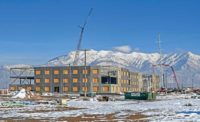New Influx of Field Data Reveals The Cost Of Ownership
..."track location, schedule maintenance, account for costs, manage projects and manage performance of assets," says Rich DiMeo, a strategy director for PeopleSoft Inc., Pleasanton, Calif.
In the meantime, the flow of data coming in to equipment managers desks is welcomed with a sigh of relief. Says Markey, "We are beginning to arrive."
|
Construction runs strong in the blood of some families and some favor the diesel and heavy iron side of the business. The Monnot family has supplied two brothers who are the top managers of the giant fleets at Fluor and Zachry and they bring surprisingly similar ironclad personalities and far-reaching knowledge of heavy-equipment operations.
Both J. Pat Monnot, 61, and J. Mike Monnot, 60, were born and raised in Northern California during World War II. Their father, Lawrence "Larry" Monnot, worked in construction as a crane operator, oiler and mechanic. His intimate understanding of construction machines fueled the two boys interest in all things mechanical. Young Pat and Mike, whose first names are John and James, respectively, never seemed to notice that their mother called them by their middle names. But confusion came later in grade school when teachers would call roll for the first time at the beginning of each school year. "I guess we forgot that we had first names," Pat recalls. Still, the tradition stuck. As young adults, both Pat and Mike were tinkerers and built racecars for fun. Pat got into construction early, signing up with Boise-based Morrison-Knudsen Co. as a dragline oiler at age 22. Soon after, he moved into estimating. By 27 years old, he was a mechanic-foreman, running graveyard shifts and responsible for about 50 other field technicians. Mike joined the Army Special Forces in 1965 and went to Vietnam. After being discharged, he joined his brother at M-K, but as a field-service mechanic on overseas projects. During his 36-year career in equipment management, Mikes work has taken him to such diverse places as Tanzania, Zaire, Egypt, Columbia and Peru. The brothers stayed at M-K for nearly 30 years. "In those days, there was lot more employer-employee loyalty," says Pat. Pat eventually served as M-Ks director of equipment administration. In that management role, Pat was responsible for M-Ks company-wide equipment policies, procedures and financial reporting. In 1979, Pat led the equipment di-visions early use of computers, then cumbersome mainframes, to track, analyze and optimize equipment performance on the 232-mile-long Tennessee Tombigbee Waterway project. During the massive earthmoving job, he managed 500 people and a fleet of heavy machinery that chewed up some 200,000 cu yd of material daily, with an average availability rating of 93.5% (ENR 1/17/80 p. 56). Real-time data gathering was not yet possible. Abroad, Mike spent years in equipment management and in 1999 was promoted to director of equipment, shortly after M-Ks operations became part of Washington Group International. Mikes equipment-management work was noticed with approval in the late 1990s by Zachry Construction Corp. as it worked with M-K as a joint venture partner on Californias East Side Reservoir project. Mike now works in San Antonio as Zachrys director of equipment, corporate tool center and scaffolding operations. The combined replacement value of his firms fleet of heavy equipment, trailers, work trucks, hand tools and scaffolding is estimated at $208 million. After working in business development for a few years in M-Ks locomotive and railcar rebuilding business, Pat switched back over to equipment management in 1990. In 1996, he left Boise after M-Ks bankruptcy and moved to Greenville, S.C., where he joined AMECO as a regional operations manager. He has served at Fluors equipment division as vice president of global operations since 2001, overseeing a $350-million fleet of 20,000 machines, trucks, portable equipment and countless small tools and rented goods all over the world. Both Pat and Mike are confident about the positive role of technology in their yards and fleet and demonstrated to ENR the various equipment technologies they have tried out in recent months. In a mock jobsite trailer used for testing tool-rental procedures, Pat showed an "invisible ink" that his firm now is painting on its thousands of hand tools. When viewed under a blacklight, the theft-deterring substance reads the name, "AMECO," in a bright blue. If someone tries to scratch the company identification off, it just becomes more imbedded in the surface of the tool. Smiling, Pat admits, "I have always been a technology freak. I love playing with state-of-the-art stuff." Mike shares his brothers eager enthusiasm for any management tool that he thinks might make his job easier at Zachrys 97.5-acre headquarters in San Antonio. Sensitive to his firms marketing image, Mikes operation includes three paint booths, a blast booth and a new venture into in-house desktop publishing and a print shop for decals to keep the vast equipment fleet looking like new. "When I put a piece of equipment out on a project, that has the Zachry brand on it," he says. The $26,000 investment in the decal operation payed for itself in the first year, he says. | ||||
|




